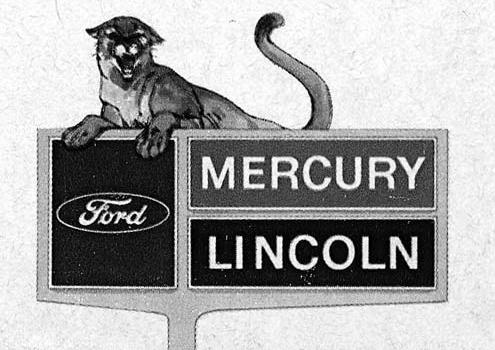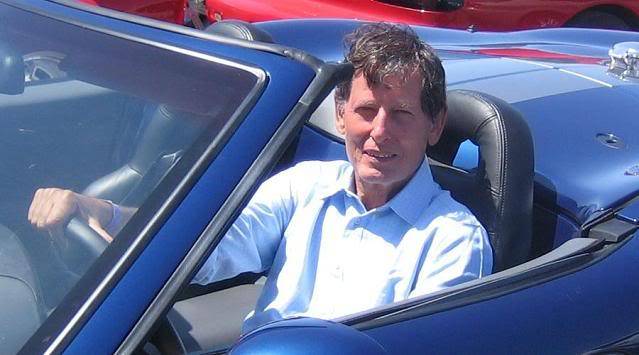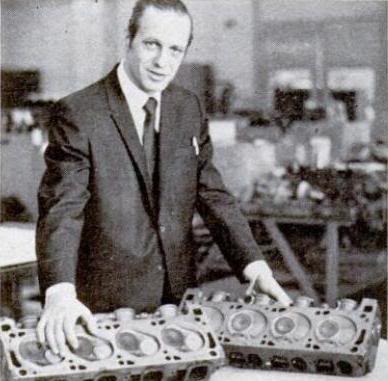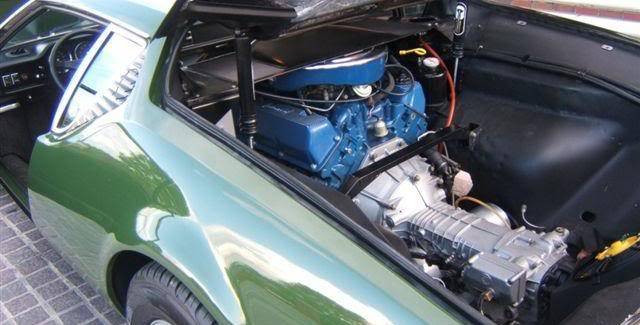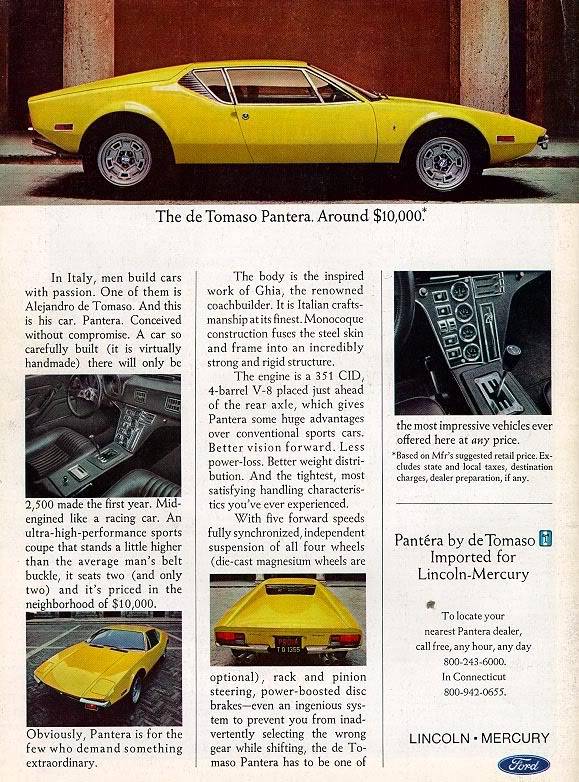|
The name "Pantera" is the Italian word for Panther. This name was was conceived by Rick McBride, the photographer who was responsible for the photos of the yellow Pantera amongst the statues and columns of ancient Rome. When McBride suggested the name to Alejandro DeTomaso he approved it immediately. We can only guess why Alejandro liked the name, perhaps because the Panther is a wild, powerful, agile and fast cat; having the qualities DeTomaso wanted people to associate with his new sports car. Perhaps because the Italian version of the name gave the car an exotic sound and emphasized to American buyers the Pantera was built in Italy. Or perhaps because the cat name fit in with Ford advertising of that era, which advised consumers considering a visit to a Lincoln Mercury dealership to "look for the sign of the cat". Besides the Pantera, other vehicles sold by Mercury included the Cougar, Lynx and Bobcat.
The Pantera's coach was designed by Carrozzeria Ghia under the direction of Tom Tjaarda, who had recently resigned a position at Pininfarina prior to taking the helm at Ghia; a position vacated by Giorgetto Giugiaro in 1969. Other coach designs credited to Mr. Tjaarda in that period include the Ferrari 365 GT California Spyder, the Mercedes 230 SL Coupe and the Fiat 124 Spyder. Mr. Tjaarda has enjoyed an enduring and prolific career in the automotive design industry and remains active in the industry to this day.
The Pantera's chassis was devised under the direction of Gian Paolo Dallara, who had resigned a position at Lamborghini to design race car chassis for DeTomaso. The Pantera's mid-engine chassis was a monocoque design featuring a classic 2500 mm (98.4 inch) wheelbase, 4 wheel independent suspension with unequal length A-arms and coil over shock absorbers, anti-sway bars front and rear, 4 wheel disk brakes, magnesium wheels shod with V rated radial tires and manual rack and pinion steering. Only 42% of the Pantera's 3100 pounds rested upon the front tires. Other sports car chassis devised in that period under Mr. Dallara's direction include the Lamborghini Miura and the BMW M1. Mr. Dallara's present-day company is one of the motorsport industry's eminent design houses of race car chassis.
The Pantera required a high performance motor to compliment its exotic coachwork and the extraordinary capabilities of its chassis. The motor responsible for the Pantera's brutish performance was Ford's 351C 4V (also called the 351 Cleveland), a V8 displacing 5.75 liters (351 cubic inches). It was a member of Ford's 335 series of motors which included the US manufactured 351C, 351M and 400; and the Australian manufactured 302C and 351C. Conceived at the peak of Ford's "Total Performance" era, the 335 series motors were the last OHV V8s designed by the Ford Motor Company. The motors were designed under the management of Ford's executive engineer for advanced engines, Bill Gay, the engineer who had managed Ford's 1963 through 1965 Indianapolis racing motor program. The 4V version of the 351C was a 520 horsepower, 7200 rpm endurance racing motor detuned to serve as Ford's performance option for production vehicles of the 1970s. The air flow capabilities, valve size, valve geometry and combustion chamber design of the 351C 4V canted-valve cylinder heads enabled them to support more horsepower per cubic inch and more rpm than the heads found on any other mass produced motor manufactured by any US or Australian automaker at that time. The motor is noted for having a wide powerband extending from idle to 7000 rpm that is punctuated by a strong mid-range rush of power; it is also noted for weighing 1 pound per horsepower in racing trim even though the major castings were all cast in iron . Several versions of the 351C were installed in the Pantera through 1989, they were sourced from both US Ford and Ford of Australia; all featured a single four barrel carburetor for metering fuel and air and hydraulically self-adjusting valve train. Power ratings ranged from 266 net horsepower to 350 gross horsepower.
Finishing the Pantera's drivetrain was a German manufactured ZF model 5DS-25 five speed manual transaxle with limited slip differential; the same transaxle that had been installed in Ford's LeMans winning GT40 race cars, as well as race cars built by Maclaren and Lola. It was also installed in the Lancia Rally 037, the Maserati Bora, the BMW M1 and DeTomaso's Mangusta.
In 1971 the Pantera trumped its musclecar, Corvette, Jaguar and Porsche competition both in looks and in performance; it was the ultimate muscle car and sports car and ruled the streets on two continents. It accelerated to 60 mph in 5.5 seconds, covered the 1/4 mile in 13 seconds flat and had a top speed of 150 mph at red-line with the standard 4.22:1 final drive in the ZF (a top speed of 150 mph was fast enough to place a car in the "super car" category in 1971). Automotive journalists of the time were unanimous in praising the Pantera's handling, claiming it set new standards for responsiveness and road holding in production automobiles. |
